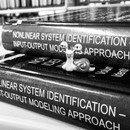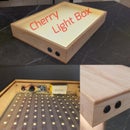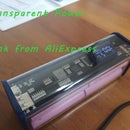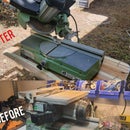Introduction: Simple Wooden Table and Benches for Kids
My son (4.5yo) has outgrown his IKEA table (LATT), but he is not there yet to conveniently use grown up size.
So, I made him a slightly bigger table, with larger top area, and two benches for him and his friends.
And now you can too!
The concept is very simple and the outcome is really sweet, the kid loves it.
Hope you like it too!
For more cool projects, follow me on IG @medanilevin
Step 1: The Design
The modelling was made in Fusion360.
This allowed me to fit everything ahead of time and also experiment with several design variations.
Here are the specs:
The table is 24" by 36" and 22" high.
The benches are 28" by 10" and 13" high.
I wanted a sturdy, compact, and simple design.
So, the table was no brainer - classic structure which you might find almost everywhere.
The benches went several revisions - I switched to diagonal legs and cross members for increased stability (have you ever seen kids at play?) and made sure they can fit under the table when not in use.
Step 2: Wood Sizes
I sourced all the wood from Home Depot, they had better selection and quality then Lowes (YMMV)
I used pine exclusively. The wider plates were cut at store, all other beams were cut with miter saw.
Note: miter saw comes in handy especially for the benches, there a 12deg cuts are needed.
If you want to do it by hand, I've included a simple jig that you can 3d print for drawing lines at angle.
The legs, table and benches, are made from 2"x2" stock.
Other beams, frames and cross members made out of 1"x2" stock.
Table top is made out of 1"x8" plates - 3 glued and screwed together.
Benches tops are 1"x10" plates.
Table:
Legs - 21" (2x2) - 4 pieces
Upper frame - 18" (1x2) - 2 pieces, 30" (1x2) - 2 pieces
Top - 36" (1x8) - 3 pieces
Bench: (multiply the following by 2 for two benches) - see attached picture for dimensions
Legs - 12" vertical, 12.25" length, cut at 12deg (2x2) - 4 pieces
Upper frame, side piece - 4" on short side, cut at 12deg in trapeze form (1x2) - 2 pieces
Upper frame, long piece - 22" straight cut (1x2) - 2 pieces
Lower cross member - 7.4" on short side, cut at 12deg in trapeze form (1x2) - 2 pieces
Lower cross bar - 22" (1x2) - 1 piece
Top - 28" (1x10) - 1 piece
Attachments
Step 3: Tools Needed
I've mentioned before, but the miter saw is really useful for this kind of work.
In addition you will need the following:
- (Miter saw)
- Drill
- Clamps, several long ones are extremely helpful
- Sander, I just love to see the grain comes to live when you sand the top layer.
- Glue - wood glue or gorilla glue are great (more on this later)
- Sanding paper, for the sander - I used 60grit and 180grit.
- Kreg jig + 1.25 bolts + bolt driver
This was my first time using the Kreg jig for joining wood, I bought the mini. with 1.25 coarse bolts and drivers.
After the experience, I think it is a good option for this kind of work. The joints are strong and you can save a lot of time.
There are a lot of YouTube videos explaining how to use it.
I will share my thoughts along the instructable.
Step 4: Starting With the Table - Legs and Frame
Let's assume all of your pieces are cut.
Now it is time to drill the pockets with your Kreg jig.
Takes time getting used to, but not terribly complicated.
- Place it in the right spot.
- Clamp it.
- Drill the hole.
The Kreg pocket are done only on the upper frame (the 1x2 pieces).
I did all of them on the inside, so these won't be visible once everything is assembled.
Just watch the direction and the right side for the hole pockets, so you won't accidentally drill it on the wrong side. Ask me how I know...
Once everything is drilled, time for the assembly.
Align the pieces like in the picture and drive the bolts in.
I also use glue on the joints, just to make it stronger.
Step 5: Table Top
The advantage of doing the frame first is using it as a support for further work, like in this case.
The table top is assembled out of 3 pieces of pine plates 1"x8"x36".
We are going to drill pocket holes in the center piece and glue and bolt the side pieces to it.
Here is the fun part: the edges of the pieces you buy at the store are rarely so square and aligned that you can just glue them.
To make them straight, ideally you "joint" them - meaning cutting new straight edge with new alignment.
I don't have a jointer, or a table saw, so here is an alternative path:
- Mix and match the sides so the gaps will be minimal.
- Drill the pocket holes on the newly identified center piece.
- Use gorilla glue (and bolts) on the joint.
- Clamp everything when waiting to dry.
I love gorilla glue!
Gorilla glue is a polyurethane adhesive which has the unique property of expanding when it comes in contact with air. The expansion will fill in the gaps and they will be invisible at the end.
A quick note here: don't expect it to fill in 1/2" (or larger) gaps, but 1/16"-1/8" should be fine.
Step 6: Finishing the Table
Once the glue is set, it is time to sand everything.
The first step is to make the edges straight, the short side of the table, where you see the three panels.
Table saw would be the best, but I don't have one, so I did everything with my trusted RYOBI.
There was some sand dust in the end, but well worth it...
In the pictures you can see the before and after, the seam is barely visible in the end, and the grain is absolutely gorgeous.
Now was the time for adjustments, I forgot to drill the pockets on the upper frame, to attach the table top.
Did 3 pockets on each beam.
I clamped my table top upside down on dining table, aligned the frame, put glue on the perimeter and secured with bolts.
Now waiting to dry.
Step 7: Benches Now
Cut all the wooden pieces.
Do the pockets with your Kreg. Note the pockets and directions on the trapezoidal cross pieces.
Also, pay attention to the direction of bolts. I tried to do the majority on the "insides" so it won't be visible at the end.
For most part it was a success. Several places required driving the bolts with hand tools (not drill) due to poor access - especially on these side trapezoidal pieces.
Assemble the frames.
The process is similar to the table, with the difference being the angled legs and more beams to connect.
Step 8: Bench Tops
The frames are ready?
It's time to sand the bench tops.
Here the job is easier, both because of the smaller area and one piece plate (instead of three with the table)
The process is familiar:
- Sand the edges.
- Sand the top and bottom with 60grit.
- Switch to 180grit and finish the job.
Here I forgot to do the top attachment pockets (as with the table), had to do it now.
Due to the lower cross beam, the pocket had to be drilled on the "outsides". Slightly visible now when passing near the table... not too bad though.
Align the top and the frame, apply glue and bolt everything together.
One of the pictures features my "hand driving" of side bolts due to poor access for the drill.
Live and learn... :)
Step 9: Finishing - Conditioning Your Wood and One Last Thing
The table and the benches are ready.
Now it is time to protect the wood and let the grain shine.
The table is for the kid, we need something to be non-toxic and still do the job.
My choice is this Cutting Board Oil by Howard.
It is just amazing how the wood starts to shine after this.
Super easy to apply and effective.
Applied a coat on everything, with extra one on the top.
Let it dry.
The final thing I did was adding these (or similar) rubber feet.
Just had to make sure nothing will slide under kids who jump on this...
That's it,
Hope you enjoyed this,
Dani
For other cool projects (and occasional bug photo), follow me on IG @medanilevin














